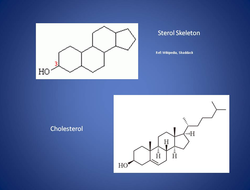Cholesterol: the good and the bad
Published: March 18, 2022
Cholesterol has come to be considered a nutrient to be avoided because of its negative association with heart disease.
Cholesterol, only present in animals, belongs to a group of lipids known collectively as sterols.
While following a vegan diet can eliminate dietary cholesterol you cannot eliminate cholesterol entirely from your body.
Cholesterol is synthesized in your liver cells from pieces of carbohydrate, protein and other lipids.
It serves as the basis for many other important compounds required for your body to function.
Your liver makes between 800 to 1500 mg of cholesterol each day which is usually much more than you would consume in your diet.
Cholesterol forms the basis of:
- Vitamin D required for calcium absorption, bone mineralization, and may be involved in;
- your immune system function
- brain and nervous system function
- reproductive organs, pancreatic tissue, and skin, muscles and cartilage
- Bile acids which are required for digestion of fats and lipids
- Adrenal hormones such as:
- cortisol: released in response to stress and acts to increase blood-glucose levels
- aldosterone: regulates blood pressure, and epinephrine and norepinephrine which stimulate your flight or fight response
- Steroid sex hormones such as, testosterone, estrogen and progesterone which are key to reproduction and expression of male and female characteristics
- HDL (high density lipoproteins) and LDL (low density lipoproteins)
As well as forming the basis of these compounds cholesterol is a necessary component of cell membranes which accounts for about 90% of all of you body cholesterol.
In addition to endogenous (within the body) cholesterol, cholesterol is obtained exogenously (outside of the body) from foods from animals such as beef, lamb, pork, poultry, fish, eggs and most dairy products.
Dairy products made from skimmed milk contain very little or no cholesterol.
During your digestion process dietary cholesterol...link to the full article to learn more.
References
1.
Gropper, S.S., Smith, J.L. & Groff, J.L. (2005). Advanced Nutrition and Human Metabolism (4thEd.). Belmont, CA: Thomson Wadsworth.
2.
Whitney, E. & Rady Rolfes, S. (2005). Understanding Nutrition. Belmont, CA: Thomson Wadsworth

